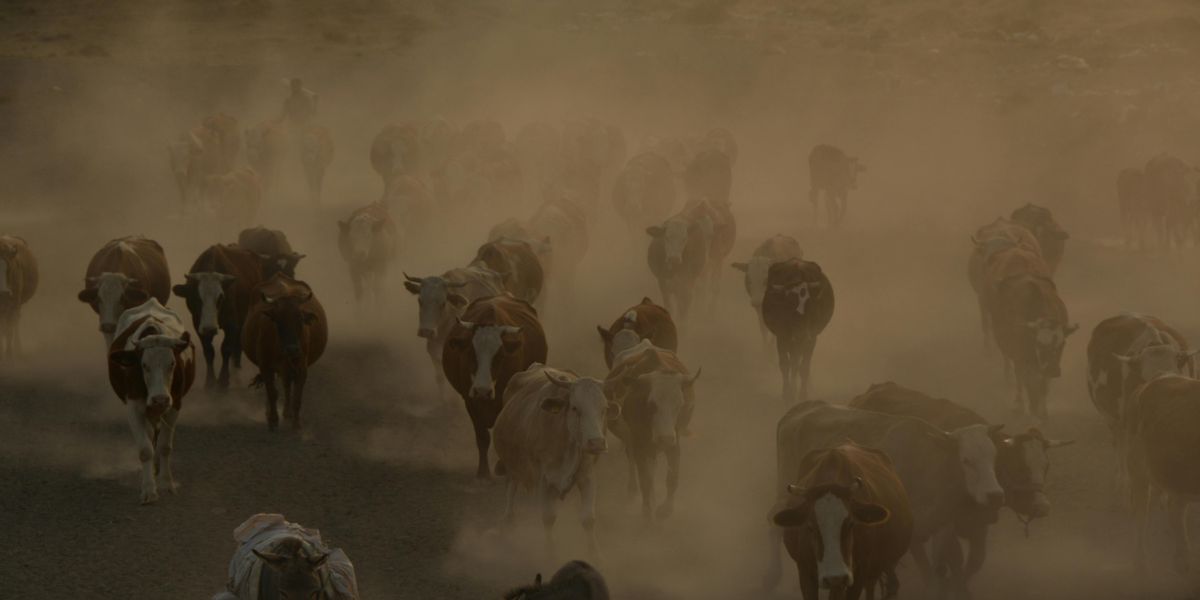Dust impact on Cattle represents a significant issue in agriculture, particularly for cattle. It affects their health, production, and the environment they live in. This article highlights how dust impacts cattle and humans, and how products like GRT: Wet-Loc can help mitigate these effects.


Dust Impact on Cattle Health
- Respiratory Problems: Dust particles can cause respiratory issues in cattle, leading to conditions like chronic bronchitis and pneumonia. Inhaling dust damages their lungs, reducing oxygen intake and overall health.
- Eye Irritation: Dust can cause eye problems such as conjunctivitis. Persistent irritation may lead to infections and impaired vision.
- Skin Issues: Dust can lead to skin irritations and infections, especially in humid conditions where it can stick to the skin and cause sores.
- Tuberculosis: This serious disease is transmitted from cattle to humans through the air. Dust particles can carry Mycobacterium bovis, the bacteria causing tuberculosis, posing a significant health risk to both cattle and humans.
Dust Impact on Human Health
- Respiratory Issues: Just like cattle, humans can suffer from respiratory problems due to dust inhalation. This includes asthma, bronchitis, and other chronic lung diseases.
- Allergies: Dust can trigger allergic reactions, causing symptoms like sneezing, itching, and skin rashes.
Economic Impact
- Reduced Productivity: Health issues in cattle lead to decreased productivity. Sick cattle grow slower, produce less milk, and have lower fertility rates.
- Increased Costs: Farmers face higher veterinary bills and may need to invest in dust control measures to keep their livestock healthy.
Dust management in Feedlots and Saleyards
Effective dust control in feedlots and saleyards is crucial to protect cattle health and ensure operational efficiency. Here are some strategies:
Dust Control in Feedlots
-
Water Spraying
- Regular Spraying: Applying water to high-traffic areas and pens helps to settle dust particles, reducing airborne dust.
- Automated Systems: Automated water spraying systems ensure consistent dust control, especially during dry and windy conditions.
-
Dust Suppressants
- Chemical Suppressants: Products like GRT: Wet-Loc can effectively bind dust particles, preventing them from becoming airborne.
- Natural Suppressants: Organic materials, such as molasses or vegetable oil, can also be used as dust suppressants.
-
Vegetative Barriers
- Windbreaks: Planting trees and shrubs around the feedlot can act as windbreaks, reducing wind speed and the amount of dust being carried away.
- Grass Cover: Maintaining grass cover in and around the feedlot helps trap dust particles and reduce dust generation.
-
Proper Site Management
- Surface Stabilisation: Applying gravel or other stabilising materials to high-traffic areas can reduce dust generation.
- Cleaning Protocols: Regular cleaning of feeding areas, pens, and alleys helps to minimise dust accumulation.
Dust Control in Saleyards
-
Surface Treatments
- Spraying Water: Regularly spraying water on dusty surfaces can help keep dust levels down during livestock movements and sales.
- Dust Suppressants: Applying dust control agents like GRT: Wet-Loc on pathways and holding pens can significantly reduce dust.
-
Facility Design and Maintenance
- Paved Surfaces: Paving high-traffic areas can minimise dust generation compared to dirt or gravel surfaces.
- Regular Maintenance: Keeping surfaces well-maintained and free from cracks and potholes can prevent dust formation.
-
Vegetation and Landscaping
- Planting Vegetation: Strategically planting grass, shrubs, and trees around the saleyard can help trap dust and reduce its spread.
- Creating Windbreaks: Windbreaks can reduce wind speeds and help prevent dust from becoming airborne.
-
Handling Practices
- Controlled Movements: Managing the movement of livestock to minimise agitation and dust generation is crucial.
- Limiting Crowding: Reducing the density of animals in holding pens can decrease dust levels.
Environmental Consequences of Dust
- Soil Degradation: Dust particles can degrade soil quality, reducing its fertility and affecting crop production.
- Water Contamination: Dust can carry pollutants into water sources, contaminating them and affecting both livestock and human populations.
GRT: Wet-Loc: A Solution
GRT: Wet-Loc is an effective dust suppression product designed for agricultural use. Here’s how it helps:
- Reduces Dust Emissions: GRT: Wet-Loc binds dust particles, preventing them from becoming airborne. This helps maintain air quality and reduces respiratory issues.
- Improves Visibility: By controlling dust, GRT: Wet-Loc enhances visibility around farms and feedlots, reducing accidents.
- Environmentally Friendly: GRT: Wet-Loc is non-toxic and safe for animals, plants, and humans. It’s designed to be sustainable and effective.
Implementation
- Regular Application: Apply GRT: Wet-Loc regularly in high-traffic areas and during dry seasons to maintain its effectiveness.
- Monitor Dust Levels: Use dust monitoring tools to measure the impact and adjust application frequency as needed.
- Combine with Other Measures: Use alongside other dust control measures like proper ventilation and maintaining vegetation cover.
Improving Farm Conditions with Dust Control
Dust impacts cattle health and productivity significantly. Using effective dust suppression products like GRT: Wet-Loc can mitigate these issues, ensuring healthier livestock and better farming conditions. This approach not only benefits the cattle but also improves the well-being of farm workers and the surrounding community.
Sources:
- Meat & Livestock Australia (MLA)
- Cattle Feeders Association
- Feedlot Magazine
- University of Illinois Agricultural Engineering News
Are environmental regulations, health and safety concerns or potential profit loss a concern right now?
Dust suppression is a critical issue in the world of mining and resources.
Learn more about GRT’s industry-leading and IoT-connected SMART Dosing Units, and discover how we’re driving better dust suppression solutions.
If you’d like to talk with an expert, simply contact us.
Your feedback matters to us.
If you enjoyed reading this Global Road Technology industry update, please let us know by leaving a REVIEW.
